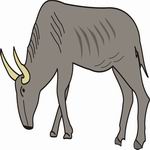- An African antelope. Its heavy head and humped shoulders resemble
those of a buffalo, while the compact hindquarters are like those of
a horse.
- As a result of its appearance, the animal is also known as a wildebeest
- an African word meaning "wild beast".
- The gnu has a beard, a short, erect mane, and a long, flowing tail.
- Gnus are grazing animals and live in herds on open grassland.
- Male and female Gnu have large horns that curve down, outward, and
up.
- Gnu calves can stand and run within three to seven minutes of being
born.
- At night white-bearded wildebeest sleep on the ground in rows; this
provides them with the security of being in a group while allowing them
space to run in case of an emergency.
- This migration takes the form of long columns, stretching thousands
of miles.
- Predators such as lions and hyenas follow the herd while crocodiles
wait hungrily in the rivers. They wait for a lone unhealthy gnu or youngster
to break away from the others; wading into a herd of over one million
hoofed animals for a meal is too dangerous.
- They constantly move in an effort to locate new pastures.
- The sight of a gnu migration, with its distinctive style of movement,
is perhaps the most impressive group event in the animal kingdom
- The white bearded gnu population has increased from around 100 000
animals in 1950 to roughly 1.5 million at present.
- Eighty percent of gnu calves (up to half a million) are born within
a two to three week period at the beginning of the rainy season.
- More than a million creatures take part in the annual gnu migrations
that are often regarded as the world's most incredible animal spectacle.
- Rather than destroying the areas over which these migrations occur,
the grazing and trampling of the grasses by such large herds helps to
stimulate grass growth.
|


